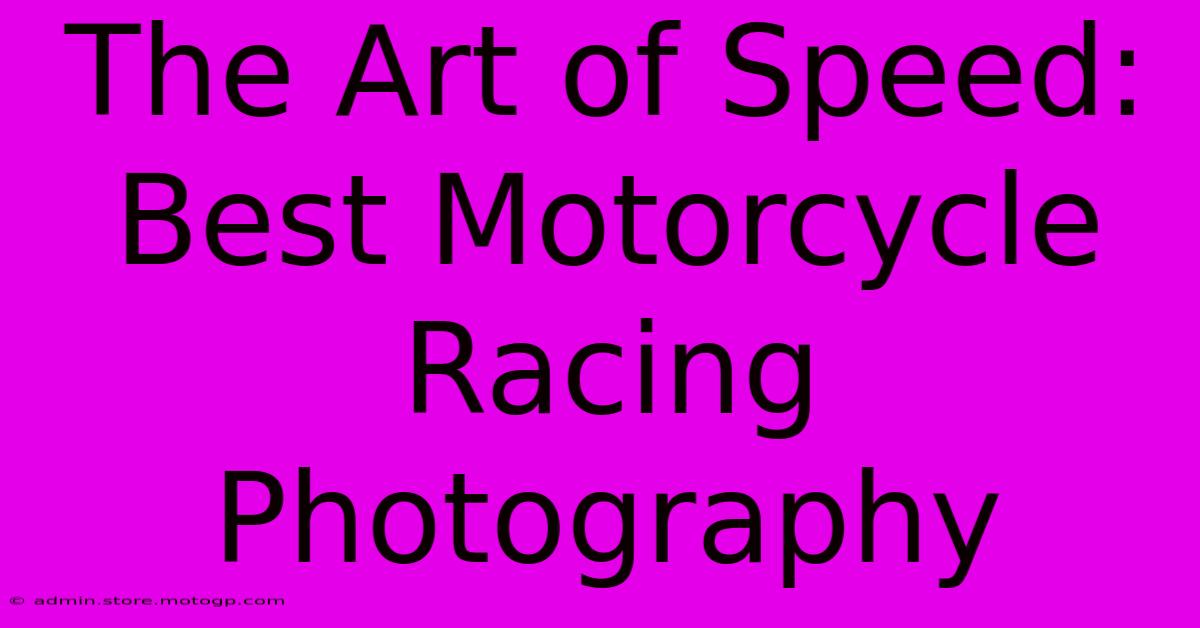The Art Of Speed: Best Motorcycle Racing Photography

Table of Contents
The Art of Speed: Best Motorcycle Racing Photography
Motorcycle racing: a symphony of speed, skill, and adrenaline. Capturing this raw energy demands more than just a fast shutter speed; it's an art form in itself. This article delves into the techniques and artistry behind stunning motorcycle racing photography, exploring how to capture the thrill and emotion of the sport.
Mastering the Mechanics: Technical Aspects of Motorcycle Racing Photography
To truly capture the essence of motorcycle racing, you need to understand the technical demands. This isn't just about pointing and shooting; it's about mastering your equipment and anticipating the action.
1. The Right Gear:
- Camera: A professional DSLR or mirrorless camera with a fast continuous shooting mode is essential. You need to be able to capture multiple frames per second to ensure you get the perfect shot. Consider cameras with robust autofocus systems capable of tracking fast-moving subjects.
- Lenses: A telephoto lens with a long focal length (at least 70-200mm, ideally longer) is crucial for capturing close-up shots of the bikes and riders. A wide-angle lens can also be useful for capturing the overall atmosphere of the race and the surrounding environment.
- Tripod (or Monopod): While not always practical during the fast-paced action, a sturdy tripod or monopod can be helpful for capturing shots from fixed positions, especially for establishing shots or capturing details.
2. Shutter Speed, Aperture, and ISO:
- Shutter Speed: This is arguably the most critical setting. You'll need a very fast shutter speed (typically 1/1000th of a second or faster) to freeze the motion of the bikes and riders. Slower shutter speeds will result in motion blur, which can be artistic in some contexts, but for sharp action shots, speed is key.
- Aperture: A relatively wide aperture (low f-number, like f/2.8 or f/4) will allow more light to reach the sensor, crucial in low-light conditions, and will also create a shallow depth of field, blurring the background and emphasizing the subject.
- ISO: Keep your ISO as low as possible to minimize noise, but be prepared to increase it in low-light conditions to maintain a fast enough shutter speed.
3. Autofocus Mastery:
Mastering your camera's autofocus system is paramount. Continuous autofocus (AI Servo or similar) is essential for tracking moving subjects. Experiment with different autofocus points and settings to find what works best for you and your camera.
The Art of Composition: Framing the Perfect Shot
Technical prowess is only half the battle. The art of composition elevates your motorcycle racing photography from snapshots to captivating images.
1. Leading Lines:
Utilize the track itself as a leading line, drawing the viewer's eye toward the action. Curves and straightaways provide natural leading lines that add dynamism to your shots.
2. Rule of Thirds:
Place the main subject off-center, following the rule of thirds, to create a more balanced and visually appealing composition. Don't center your subject unless there's a compelling artistic reason.
3. Background Elements:
Be mindful of the background. A cluttered background can distract from the main subject, while a clean and uncluttered background can enhance the impact of your shot.
4. Capturing Emotion:
Look beyond just the bikes; capture the emotion of the riders, the intensity of the race, and the energy of the crowd. These elements add depth and narrative to your photography.
Beyond the Basics: Creative Techniques
To truly stand out, experiment with different creative techniques:
- Panning: Follow the bike with your camera as it moves, creating motion blur in the background while keeping the bike relatively sharp. This technique adds a sense of speed and dynamism.
- Silhouettes: Capture silhouettes of bikes against a bright background, such as the setting sun, for dramatic and evocative images.
- Dramatic Lighting: Use the available light to your advantage. The setting sun or the artificial lights of a night race can create stunning visual effects.
Off-Track Considerations: Building Your Portfolio
Great motorcycle racing photography requires more than just skill behind the camera. Building a strong portfolio involves strategic planning and promotion.
- Networking: Connect with race organizers, teams, and other photographers to gain access to events and potentially collaborate.
- Online Presence: Create a website or online portfolio to showcase your best work. Use social media platforms to share your images and connect with a wider audience.
- Image Editing: Post-processing is essential to enhance your images. Master image editing software to refine colors, sharpness, and overall composition.
By mastering both the technical aspects and the art of composition, and by strategically building your presence, you can create stunning motorcycle racing photography that captures the speed, emotion, and drama of this exhilarating sport. Remember, practice makes perfect! The more you shoot, the better you'll become at capturing those fleeting moments of adrenaline-fueled action.

Thank you for visiting our website wich cover about The Art Of Speed: Best Motorcycle Racing Photography. We hope the information provided has been useful to you. Feel free to contact us if you have any questions or need further assistance. See you next time and dont miss to bookmark.
Featured Posts
-
Moto 3 Bikes Your Passport To The World Of Racing
Feb 19, 2025
-
Circuit Of The Americas Lot F The Parking Solution You Need
Feb 19, 2025
-
Moto Gp Austin Dates Your Ticket To Thrilling Racing Action
Feb 19, 2025
-
Moto Gp Accident The Importance Of Continuous Learning
Feb 19, 2025
-
Best Motorcycle Racing Find Your Perfect Ride
Feb 19, 2025
